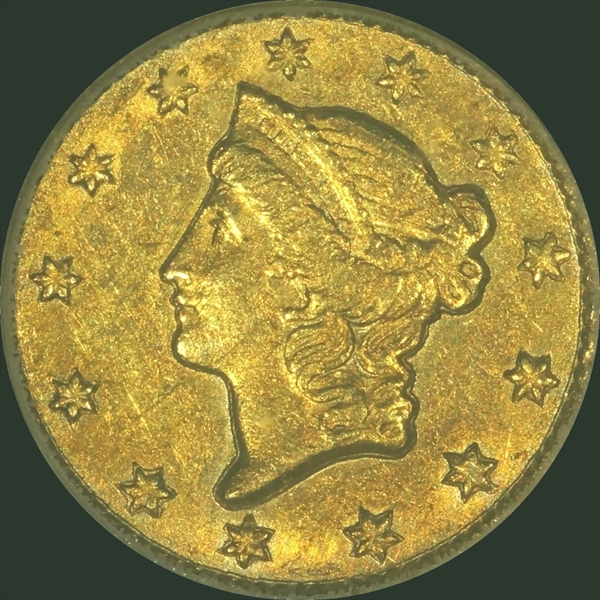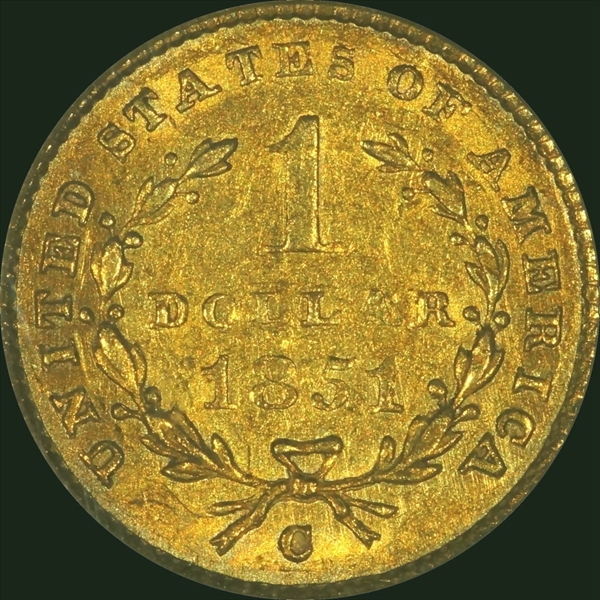1851-C G$1 AU58 认证号21370535, PCGS号7514
拥有者评论
The California Gold rush and private minters like the Betchler's pressured Congress to adopt a new denomination, the gold dollar. The gold dollar was first produced in 1849 at all four mints, Philadelphia, New Orleans, Dahlonega, and Charlotte. This coin minted at the Charlotte Mint has beautiful golden toning and nice strike.
专家评论
David Akers (1975/88)
The 1851-C is the most common C Mint gold dollar, and the only one reasonably obtainable in full mint state.Doug Winter
During the five years in which Type One Gold dollars were struck at the Charlotte Mint (1849-1853), a total of 80,816 pieces were produced. Of these 41,267 (or 51.06%) were dated 1851-C. As one might expect, the 1851-C is by far the most common Type One Charlotte Gold dollar. It is also the most plentiful issue of any denomination from this mint, both in terms of the total number known in all grades and the amount of high grade examples that have survived.The 1851-C is the most common Charlotte gold dollar. It is also the most easily obtained Charlotte coin of any year or denomination. This issue can be found in any circulated grade without much effort. It is only moderately scarce in the lowest Uncirculated grades. In properly graded MS62 it becomes scarce and it is rare in MS63 or better. There are at least a half dozen Gem examples known and these are among the finest surviving coins from the Charlotte Mint.
STRIKE: The obverse of the 1851-C tends to be better struck than other gold dollars from Charlotte. Pieces exist with almost no weakness on their hair and full radial lines within the stars. The typical coin, however, has a bit of weakness at the top of Liberty’s head and the stars from 4:00 to 6:00. The border is often weak and may show noticeable die rust, especially from 2:00 to 5:00. The reverse is always not as well struck as the obverse. The date is usually sharp as is the value and mintmark. Weakness is seen on TES in STATES and at the border on the right. This issue is excellent for use as a type coin due to the relative available of well struck examples.
SURFACES: The quality of the surfaces on the 1851-C varies greatly. There are some extremely clean coins known that have very smooth fields. Others show mint-made striations. Many have clusters of small marks, especially in the left obverse field. It is not uncommon for higher grade 1851-C gold dollars to have a “ring” at the peripheries that is slightly different in texture than the inner portions and different in coloration than the rest of the coin.
LUSTER: The luster is excellent and is a higher quality than on any other gold dollar from this mint. Original, high grade pieces display thick, frosty luster which is more suggestive of a Philadelphia issue from this era than one from Charlotte. A smaller number are seen with a grainy, slightly satiny texture. I can only recall seeing a few that were prooflike.
COLORATION: A fairly wide range of colors have been observed on examples of this date. I have seen pieces that were a medium to deep orange-gold hue and others that were more of a green-gold shade. There are still a relatively large number of 1851-C gold dollars with natural color but, as with all Charlotte coins, these are becoming more and more difficult to find.
EYE APPEAL: There are some outstanding examples known. With patience, the collector should be able to find an 1851-C gold dollar that is well struck, lustrous and attractively toned. However, it is becoming harder to find nice high grade pieces as more and more are dipped or brightened.
DIE CHARACTERISTICS: Some 1851-C gold dollars show clashmarks.
DIE VARIETIES: Three Die Varieties are known. It is possible that at least one other exists.
Variety 1 (formerly Variety 4-D): The first 1 in the date is centered below the O. The stars are heavy and exhibit doubling. The wreath also shows doubling. The mintmark is perfect and shows no signs of doubling. Early die states show four clashmarks from the head within the wreath. These fade and later die states show no signs of these clashmarks. Some coins from this die pair have a break atop OF AM in the legend.
Variety 2 (formerly Variety 5-E): The stars are somewhat heavy and exhibit no doubling. The wreath exhibits this as well. The wreath is lighter than on Variety 1. The mintmark is lightly doubled.
Variety 3 (formerly Variety 6-F): The first 1 in the date is below the left side of the O. The stars at the upper part of the obverse are lightly impressed while those at the bottom are more heavily impressed. The date is higher than on the other two varieties while the mintmark shows the most pronounced doubling on any of the three varieties. Doubling can also be seen on UNITED STA and ICA in AMERICA. The bottom of the E in STATES is clearly recut. There is a crack from the rim to the second S in STATES which quickly identifies this variety. Variety 3 is much scarcer than Variety 1. I have never seen an example of Variety 2, but I am relying on Breen’s findings. If it does exist, it would be the rarest variety of this date.
PCGS #
7514
设计师
James Barton Longacre
边缘
Reeded
直径
12.70 毫米
重量
1.70 克
铸币数量
41267
金属成分
90% Gold, 10% Copper
更高评级数量
93
评级较低的钱币数量
307
地区
The United States of America
价格指南
PCGS 数量报告
拍卖 - PCGS 评级的
拍卖 - NGC 评级的
稀有性和存量估计 了解更多
| 所有评级 | 600 |
| 60或以上 | 75 |
| 65或以上 | 8 |
| 所有评级 | R-5.8 |
| 60或以上 | R-8.2 |
| 65或以上 | R-9.6 |
| 所有评级 | 17 / 26 TIE |
| 60或以上 | 15 / 26 |
| 65或以上 | 8 / 26 TIE |
| 所有评级 | 53 / 81 TIE |
| 60或以上 | 34 / 81 TIE |
| 65或以上 | 14 / 81 TIE |
状况普查 了解更多
 #1 MS66 PCGS grade
#1 MS66 PCGS grade
Bob R. Simpson Collection |
| #1 MS66 PCGS grade |
| #1 MS66 PCGS grade |
| #3 MS65 PCGS grade |
| #3 MS65 PCGS grade |





















